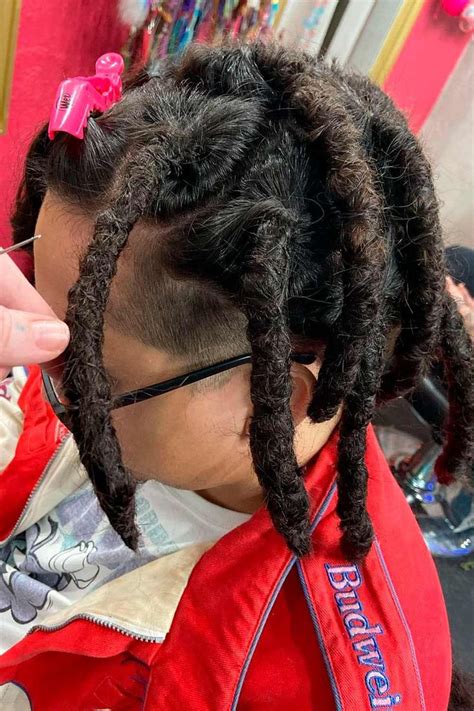Introduction

Small wicks dreads, also known as microlocks, are a unique and intricate style of dreadlocks that have gained increasing popularity in recent years. Unlike traditional dreadlocks, small wicks dreads are created with tightly rolled sections of hair that result in thin, rope-like strands. This article will provide a comprehensive guide to creating and maintaining small wicks dreads, including techniques, tips, and troubleshooting advice.
Understanding Small Wicks Dreads
What are Small Wicks Dreads?
Small wicks dreads are a style of dreadlocks characterized by their thin, tightly rolled strands. They typically range in diameter from 1-3 millimeters and can be created using various techniques, such as interlocking, crochet, or palm rolling.
Benefits of Small Wicks Dreads:
- Versatility: Small wicks dreads offer a wide range of styling options, from loose and flowing to intricate updos.
- Low Maintenance: Compared to traditional dreadlocks, small wicks dreads require less frequent washing, moisturizing, and retwisting.
- Healthier Hair: The tight rolling technique helps prevent hair breakage and protects the scalp from the elements.
Creating Small Wicks Dreads
Sectioning the Hair
- Divide your hair into small sections, approximately 1-2 centimeters in width.
- Secure each section with a rubber band or hair clip.
Rolling the Strands
- Take a section of hair and comb it out to remove any tangles.
- Starting at the root, roll the hair tightly and evenly towards the ends.
- Use a crochet hook or needle to tighten the rolls and create a secure hold.
Interlocking the Strands (Optional)
- Once the strands are rolled, take two adjacent sections and intertwine them.
- Use a crochet hook to pull the hairs through from one strand to the other, creating a locked connection.
Palm Rolling (Optional)
- Hold a rolled strand in between your palms and rub them together vigorously.
- This motion will further tighten the roll and create a more defined dread.
Alternative Techniques
- Dreading Sponge: Rub your hair against a dread-making sponge to create small knots that form the base of the dreads.
- Backcombing: Backcomb the hair at the roots and then roll the strands to create a textured and frizzy base.
- Waxing: Apply beeswax or another natural wax to the hair and roll the strands to hold them in place.
Maintaining Small Wicks Dreads
Washing
- Wash your hair every 2-4 weeks with a residue-free shampoo and avoid using conditioner.
- Use a deep conditioning mask once a month to hydrate and nourish your dreads.
Moisturizing
- Moisturize your dreads regularly with a natural oil or wax to keep them soft and prevent dryness.
- Avoid using heavy products that can weigh down your dreads.
Retwisting
- Retwist your dreads every 4-6 weeks to maintain their shape and prevent tangling.
- Use the same rolling technique as when you initially created the dreads.
Troubleshooting
Loose Dreads: If your dreads become loose, you can palm roll them or use a crochet hook to tighten them.
– Knotting: If your dreads become knotted, gently separate them using a crochet hook or a comb.
– Dandruff: If you experience dandruff, wash your dreads more frequently and use an anti-dandruff shampoo.
– Itching: If your scalp becomes itchy, apply a soothing oil or cream to the affected area.
Tables for Useful Information
| Maintenance Schedule for Small Wicks Dreads |
|—|—|
| Washing | Every 2-4 weeks |
| Deep Conditioning | Once a month |
| Moisturizing | Regularly, as needed |
| Retwisting | Every 4-6 weeks |
| Common Problems and Solutions for Small Wicks Dreads |
|—|—|
| Problem | Solution |
| Loose Dreads | Palm roll or tighten with a crochet hook |
| Knotting | Gently separate with a crochet hook or comb |
| Dandruff | Wash more frequently and use anti-dandruff shampoo |
| Itching | Apply soothing oil or cream |
FAQs
-
How long does it take to create small wicks dreads?
– The time it takes to create small wicks dreads varies depending on the length and thickness of your hair. On average, it can take several hours or even days. -
Are small wicks dreads permanent?
– Yes, small wicks dreads are permanent once they are fully matured. However, they can be removed through professional methods or by cutting them out. -
Can I create small wicks dreads on all hair types?
– Small wicks dreads can be created on most hair types, including straight, curly, and coily hair. However, very fine or damaged hair may not be suitable for this style. -
How can I prevent my small wicks dreads from unraveling?
– Regular washing, moisturizing, and retwisting are crucial for preventing unraveling. Additionally, avoid excessive brushing or combing and use products designed for dreadlocks. -
Do small wicks dreads damage my hair?
– If maintained properly, small wicks dreads do not damage your hair. In fact, they can protect your hair from breakage and environmental damage. -
Can I dye small wicks dreads?
– Yes, you can dye small wicks dreads. However, it is important to use a dye specifically designed for dreadlocks and to follow the manufacturer’s instructions carefully. -
What are some creative ways to style small wicks dreads?
– Small wicks dreads can be styled in numerous ways, such as buns, braids, ponytails, twists, and half-up styles. You can also add accessories like beads, wraps, or scarves to enhance their appearance. -
Can I create small wicks dreads at home?
– While it is possible to create small wicks dreads at home, it is best to seek professional help from a licensed loctician, especially for first-timers. A loctician can ensure proper technique and prevent potential damage to your hair.
